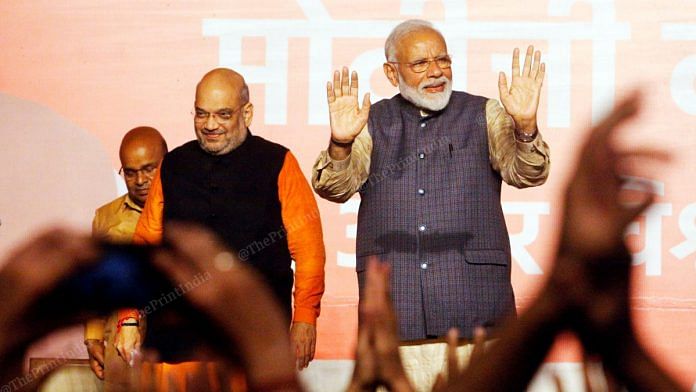New Delhi: In a vindication of its strategy to replace sitting MPs from seats that it had believed to be ‘vulnerable’ and would yield more space to allies, the Bharatiya Janata Party (BJP) has done overwhelmingly well in all such constituencies, winning over 90 per cent of them.
According to a detailed analysis by ThePrint, the NDA won 93 per cent of the seats where the BJP denied tickets to sitting MPs — either because the party was not convinced about their winnability or due to their age or because the seat had to be given to an ally.
In some cases, sitting MPs, who had quit the party in the last five years, had to be replaced by new faces. For instance, Dalit leader and first-time MP from Bahraich in Uttar Pradesh Savitribai Phule had quit the BJP in December last year, accusing the party of being anti-Dalit. She was replaced by Akshaibar Lal, who won by a convincing margin of 1.2 lakh votes.
The biggest example of the success of this strategy is Chhattisgarh where the BJP dropped all 10 sitting MPs after the drubbing in last year’s Assembly polls. Of these, the party managed to win as many as eight seats, thus successfully reversing the state poll rout by surging past the Congress and winning nine of the state’s 11 Lok Sabha seats.
The Prime Minister Narendra Modi-led BJP marched back to power Thursday, winning 303 of the 543 seats.
The findings
ThePrint had earlier reported the BJP had dropped 35 per cent of its first-time MPs, not deeming them fit to fight elections again.
The BJP’s strength in the Lok Sabha at the end of the five years was 268. Overall, the party denied tickets to 97 sitting MPs. Of these, it managed to win a very healthy 82 seats on its own. Further, in eight other seats, the BJP had to accommodate allies and thus, denied tickets to its own MPs in seats such as Gaya and Gopalganj in Bihar or Robertsganj in Uttar Pradesh — the NDA has won in all these seats.
Effectively, the BJP suffered setbacks only in around seven seats where it did not repeat its MPs. Among these were Narsapuram and Visakhapatnam in Andhra Pradesh as well as Korba and Bastar in Chhattisgarh.
Then, there were around seven MPs, who were not nominated from their current seats, but they fought the elections from separate constituencies. So, while Maneka Gandhi and her son Varun exchanged their seats in Uttar Pradesh — Pilibhit and Sultanpur — S.S. Ahluwalia was made to leave Darjeeling in West Bengal and fight from Burdwan-Durgapur seat. Similarly, Ram Shankar Katheria fought from Etawah in Uttar Pradesh instead of Agra, and Giriraj Singh fought from Begusarai in Bihar instead of Nawada, which went to ally Lok Janshakti Party (LJP). The BJP has won all these seats.
Also read: 12 reasons why Modi-Shah’s BJP got the better of Congress & everyone else
The anti-incumbency factor
The BJP knew the 2019 fight was unlike the one in 2014 when it had no baggage of incumbency. Five years in power, however, meant an anti-incumbency sentiment had set in, particularly against some sitting legislators. The party knew merely Modi’s popularity and its shrill national security narrative might not be enough to salvage the situation in seats with weak MPs.
To avoid this, the party’s top brass decided to replace the vulnerable MPs with fresh faces — a strategy that clearly worked, helping the BJP to cross the 300 mark.
This game plan was particularly useful in states like Uttar Pradesh, where it had won 71 of the 80 seats in 2014, but was battling a strong Samajwadi Party-Bahujan Samaj Party alliance, and in Assam, where it wanted to better its 2014 tally and was worried about the backlash against the Citizenship (Amendment) Bill.
In Uttar Pradesh, the BJP either denied tickets to or changed the seats of nearly 30 of its sitting MPs and won most of the seats. In Assam, it dropped MPs in five of its seven seats, winning all.
Moreover, yielding space to allies — especially in Bihar — where the BJP adjusted with the JD(U) and LJP by contesting lesser seats than it had won in 2014 also proved to be a clever move. In Bihar, for instance, the NDA swept the polls, winning 39 of the 40 seats.
The age factor
The unwritten rule in the BJP of not allowing those above 75 years to contest also paid off. Veteran leaders like L.K. Advani, Murli Manohar Johi, Bhagat Singh Koshyari and Sumitra Mahajan did not enter the poll fray, but the party retained their seats.
Senior leaders Sushma Swaraj and Uma Bharti, both of whom served as cabinet ministers in the outgoing government, also chose to stay out, but BJP won in their constituencies — Vidisha in Madhya Pradesh and Jhansi in Uttar Pradesh, respectively.
Also read: Smriti Irani’s makeover: From being most disliked Modi minister to dynasty slayer in Amethi




Ms Hema Malini has been very lucky to escape the cull. That colour coordinated photograph of her harvesting ears of golden wheat seems to have helped …